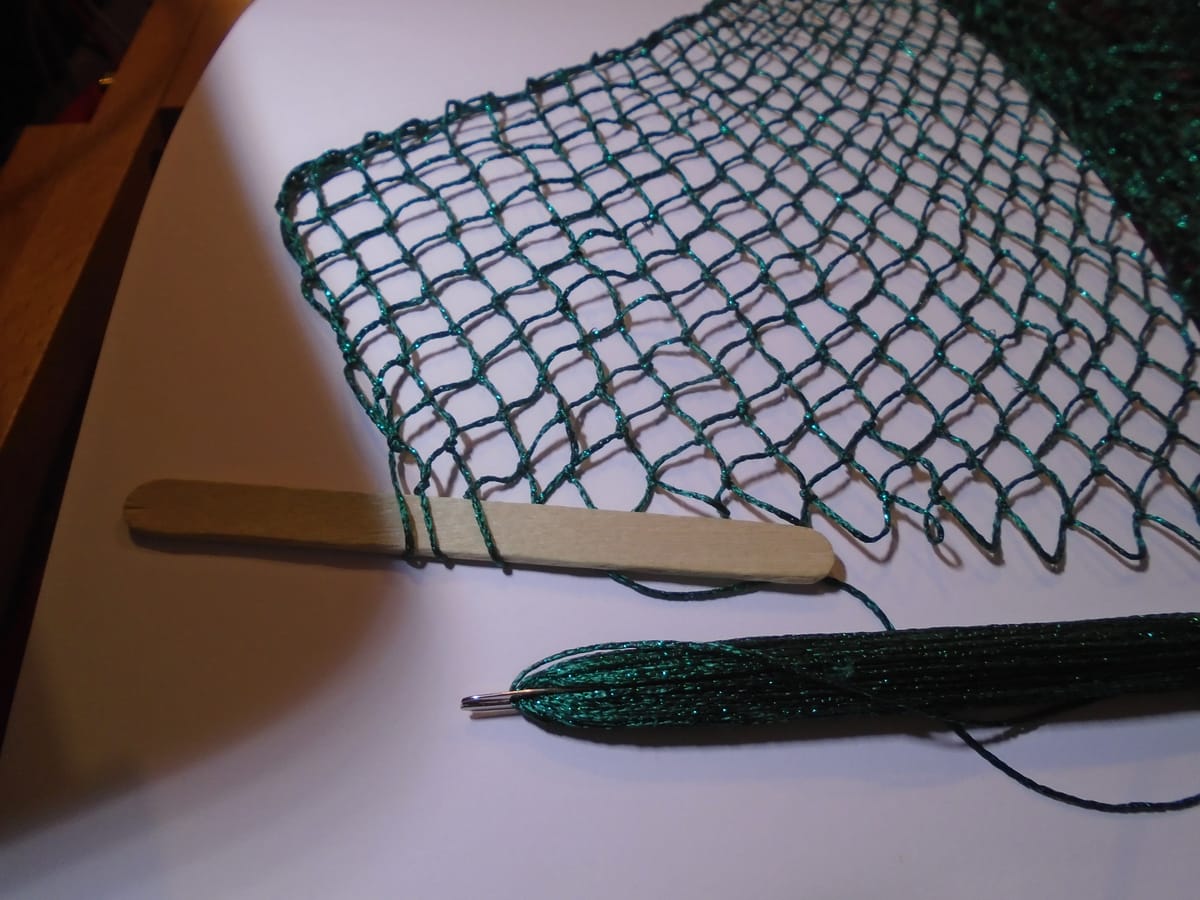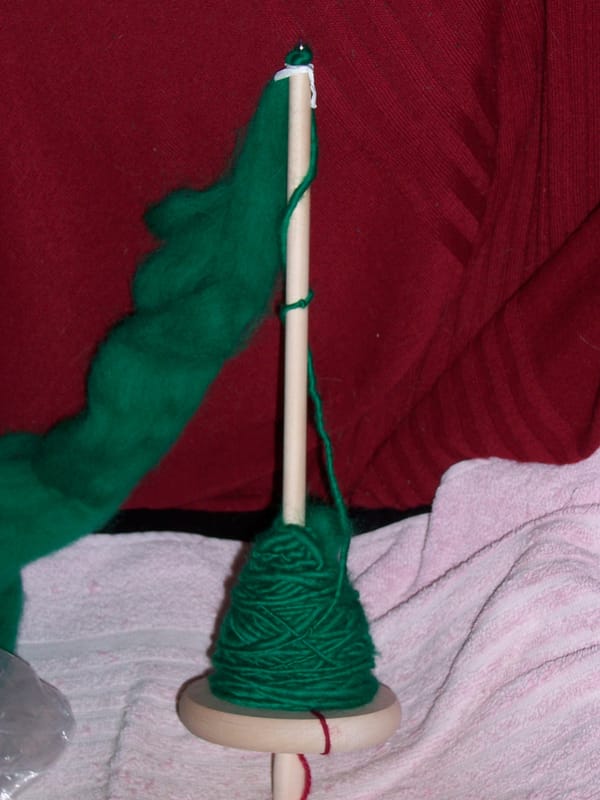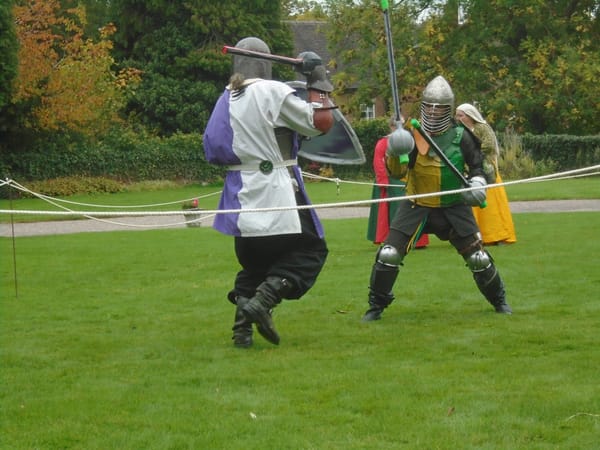Turning the corner

I think I've explained about square mesh netting before, but here is a quick reminder: it's worked diagonally, just like any other kind of netting, but you start from one corner and work across to the opposite corner. If you're doing a rectangle, then you have alternate increases and decreases in the middle bit, but if you're doing a square, as I am for this shawl, you don't have to think about that. You just increase till the sides are as long as you want them to be (in this case, about a metre), and then you start decreasing. To quote a certain Russian meerkat... simples. (I don't think they actually have meerkats in Russia; but it was still a brilliant bit of advertising, and I very rarely say that.)
Anyway, I have been batting away at this shawl, and on Friday night, much to my satisfaction, I reached my more-or-less metre (couldn't measure it precisely due to the way I had it anchored, so what I did was to measure a bit of it and then work out the number of squares I needed), which meant that on Saturday morning I could start the decreases. In the process of doing this, I learnt an interesting thing for future reference.
You see, in netting, an increase stitch is a half-mesh. You're meshing twice into the same loop, so the first mesh is a full square/diamond as normal, and then the second is this little thing that is precisely the gauge of your mesh stick. I also do increases when making my string bags, but for those it's not a problem, because the jute twine I use for the bags is so thick that you can't wind very many turns of it onto your netting needle before it's in danger of falling off the ends. So the needle and its load never becomes too thick to go through a half-loop. But the fingering-weight yarn I'm using for the shawl is very much finer, and so if you're not careful you can end up winding so much of it onto the needle that pushing it through the half-loop becomes quite an undertaking. Having done that once, and had a tremendous struggle to get it through that half-loop, I promptly learnt from my mistake, and subsequently proceeded as follows. I would wind the needle until it would just about go through one of the half-loops comfortably. Then I would count how many loops I had to go till the end of the row I was on, estimate how much yarn I would need for that (one half-turn does about four meshes, give or take), and wind that amount of extra yarn onto the needle, so that by the time I got to the half-loop it would go through reasonably easily.
Ah, but decreasing... you don't need to do any of that. You're not increasing, so there are no half-loops; all the meshes are full size, so the needle will always go through them no matter how full it is. (For even finer thread, this may not turn out to be the case, but I'll cross that bridge when I come to it.) So I can just wind a full needle every time and not think about it, which means everything goes a good deal faster.
And while we're on the subject of netting, our pastor decided that we were going to do a community craft session on Holy Saturday this year. (Not that we call it Holy Saturday. That's the residual Anglican in me talking. We just call it the day before Easter Sunday.) So I said, "Great! I'll teach netting, if we can find enough anchor points." Our pastor thought this was a splendid idea, and felt there would be plenty of table legs available for that purpose (and, indeed, if we're really pushed for anchor points, there is always the stirrup technique - you make a long loop of string and put your foot in it, then anchor the netting to that).
There is just one thing, though. Netting is a rapidly declining craft (which is one of the reasons I'm so keen to revive it). Getting hold of the needles is therefore something of a problem. There is, as far as I know, only one supplier in the UK who sells decent netting needles (though you can probably get the old boat-shaped style on Etsy, since they're not hard to carve from a piece of wood; those look great but are really only suitable for coarse mesh), and she has very low stocks. If you want any, I suggest you get them now, as she has only two left in the 21 cm size and four in the 17 cm; she has rather more in the smaller sizes, but I wouldn't recommend those to a beginner. She has to get them from Italy, and she says she won't be ordering any more from that company as their minimum order is very high and the netting needles don't sell well.
Anyway, we put our heads together via e-mail, and it turns out that one of her other suppliers, who is based in the UK, happens to do them in packs of three - one each of 21 cm, 19 cm, and 17 cm. I had already resigned myself to the fact that the class was going to have to use mixed sizes, and at least this way we'd have more of the larger needles. So I have provisionally put us down for three of these mixed packs, meaning I can take a class of up to nine people.
Peter, James, and John would have approved (and probably Andrew, too, though there's nothing I can recall that specifically says he was a fisherman). I mean, there wasn't Simeon bar-Judah's Maritime Supplies conveniently situated on the shores of the Sea of Galilee. If you were a fisherman in those days, you made your own nets; and possibly you even built your own boats. You certainly had to know how to repair them yourself. It wasn't just a case of throwing a net over the side and waiting. It was a pretty skilled job. An interesting historical note is that they probably didn't use mesh sticks; they would most likely have gauged the size of the meshes by eye. If that is the case, then hats off to them, because I'd never get it even without a mesh stick (sometimes it's hard enough even with one, depending on exactly how the knots fall).
Anyway. I don't know if Peter, James, and John ever made string bags, but that's what I'm going to have my class doing. I'll make them each a grommet to start them off, because there is no point trying to teach grommets before they can do basic netting, and we'll just take it from there.
Of course, if any of the class wants to go on to learn filet, my cup will be overflowing!




